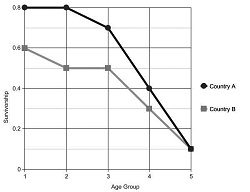Demography - Human Population Ecology
A cemetery is an excellent place to study human demography. Demography is defined as "the study of the characteristics of human populations, such as size, growth, density, distribution and vital statistics". Gravestones record the dates of birth and death, which can be used to calculate death rates and draw survivorship curves.
A survivorship curve is simply a graphical representation of the chance that an individual will survive from birth to a particular age. By comparing survivorship curves for different periods of time, we may look for historical trends in demography over the decades.
Over the last few centuries, advances in health care and large-scale global political conflict have left opposing marks on the demographics of our population. Two major time intervals stand out: before 1950 and after 1950. People who died before 1950 witnessed the industrial revolution, the ravaging effects of polio, as well as World Wars I and II. Following 1950, numerous vaccines and antibiotics were widely used, and with the exception of a few non-global scale wars, this has been an era of relative peace in North America. What do you predict about how the demographics of the human population have changed during these two time periods?
Demographics from local cemeteries can be used, but in order to get a broader scope of life in the US, the world wide web can be used to gather data about birth and death rates all over the country. Many cemeteries now have databases that list all individuals buried there. This is a much faster way than visiting all cemeteries in an area and making assumptions about the overall US population.
Objectives: Once you have completed this lab, you will understand:
1. Some of the basic concepts of population demography
2. How factors such as advances in medicine and environmental protection may have affected human demography over the past 150 years
3. How human demography might change in the future, based on the current socio-political reality and the presence of incurable diseases.
Hypotheses
Write your answers to each question below before you start collecting data (use separate page)
1. In general, what are your predictions about death rates of people before or after 1950?
2. For infants of both sexes, would you expect infant mortality to be higher or lower before or after 1950? Why?
3. How might the survivorship of females differ from that of males in the 20-30 age group? (Why?)
Methods --- Internet connection and cemetery database found at www.interment.net (collect from different sources).
Alternately, you could use library resources, cemetery records, or records from city hall.
Data Table I
Females who died before 1950 |
Females who died after 1950 |
Males who died before 1950 |
Males who died after 1950 |
Death year______ |
Death year______ |
Death year______ |
Death year______ |
Death year______ |
Death year______ |
Death year______ |
Death year______ |
Death year______ |
Death year______ |
Death year______ |
Death year______ |
Death year______ |
Death year______ |
Death year______ |
Death year______ |
Data Table II: Calculations of Survivorship and Mortality
1. To calculate the # alive, place your total number of deaths in the first row (0-9) of column B. This is the total number of people in your group upon which death took its toll as they grew older.
| Sample Calculations | ||
| Age Group | # of deaths | # alive |
| 0-9 | 2 | 20 (what you start with) |
| 10-19 | 4 | 18 (20-2) |
| 20-29 | 1 | 14 (18-4) |
| 30-39 | 2 | 13 (14-1) |
2. Subtract the number who died in each age interval (column A) from the number who were "alive" in your sample from the beginning of that age interval. Write this number in the next row in column B. Repeat to fill out column
3. Calculate the survivorship - for each row in column C, divide the number in column B by the TOTAL you found at the bottom of column A. This gives you the fraction of people that survived to each age interval. By definition, the survivorship of the first age interval equals 1.0 (all living newborns have survived to that point)
| Females Who Died Before 1950 | |||
| Column A | Column B | Column C | |
| Mortality (M) = # of deaths per age interval | # "alive" at the beginning of age interval | Survivorship (S) | |
| 0-9 | 1.0 (by definition) | ||
| 10-19 | |||
| 20-29 | |||
| 30-39 | |||
| 40-49 | |||
| 50-59 | |||
| 60-69 | |||
| 70-79 | |||
| 80-89 | |||
| 90-99 | |||
| 100-109 | |||
| Total Number of Deaths for data set___________ |
|||
| Females Who Died After 1950 | |||
| Column A | Column B | Column C | |
| Mortality (M) = # of deaths per age interval | # "alive" at the beginning of age interval | Survivorship (S) | |
| 0-9 | 1.0 (by definition) | ||
| 10-19 | |||
| 20-29 | |||
| 30-39 | |||
| 40-49 | |||
| 50-59 | |||
| 60-69 | |||
| 70-79 | |||
| 80-89 | |||
| 90-99 | |||
| 100-109 | |||
| Total Number of Deaths for data set___________ |
|||
| Males Who Died Before 1950 | |||
| Column A | Column B | Column C | |
| Mortality (M) = # of deaths per age interval | # "alive" at the beginning of age interval | Survivorship (S) | |
| 0-9 | 1.0 (by definition) | ||
| 10-19 | |||
| 20-29 | |||
| 30-39 | |||
| 40-49 | |||
| 50-59 | |||
| 60-69 | |||
| 70-79 | |||
| 80-89 | |||
| 90-99 | |||
| 100-109 | |||
| Total Number of Deaths for data set___________ |
|||
| Males Who Died After 1950 | |||
| Column A | Column B | Column C | |
| Mortality (M) = # of deaths per age interval | # "alive" at the beginning of age interval | Survivorship (S) | |
| 0-9 | 1.0 (by definition) | ||
| 10-19 | |||
| 20-29 | |||
| 30-39 | |||
| 40-49 | |||
| 50-59 | |||
| 60-69 | |||
| 70-79 | |||
| 80-89 | |||
| 90-99 | |||
| 100-109 | |||
| Total Number of Deaths for data set___________ |
|||
Data Analysis
Make a graph of survivorship (Y axis) as a function of age group (X axis). Each data set should have its own line (one line for females who died before 1950, one line for females who died after 1950, one line for males who died before 1950, and a line for males who died after 1950.
Use Create A Graph or another program to construct your graph. Hand drawn graphs are acceptable as long as they are neat and constructed on graph paper.
1. What is your interpretation of the juvenile (age 0-19) mortality pre and post 1950 for males and for females. List all factors that might account for any differences you see.
2. What is your interpretation of mortality for reproductive age adults (20-40) for pre and post 1950 for males and for females? List all factors that might account for any differences you see.
3. In Africa, AIDS takes its toll on the population, but deaths occur most frequently in the 20-40 age group. Show a survivorship curve that would illustrate this pattern.
4. What shifts in survivorship and mortality curves would you expect if significant cuts were made in social services such as prenatal and infant care?
5. Compare the two curves below: Which country is probably the better place to live? Defend your answer.

